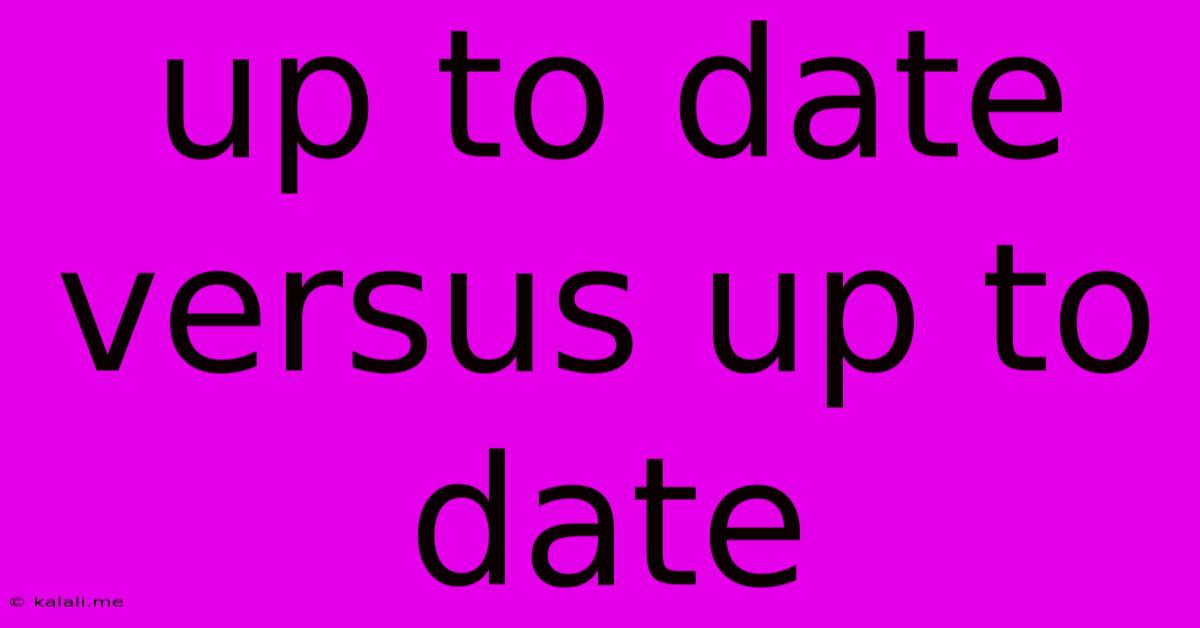Up To Date Versus Up To Date
Kalali
May 24, 2025 · 3 min read

Table of Contents
Up to Date vs. Up to Date: Decoding the Subtle Difference
The phrase "up to date" seems straightforward, but a closer look reveals a nuanced distinction between its uses. While seemingly identical, the subtle difference lies in context and emphasis. This article will dissect the subtle distinction between these seemingly interchangeable phrases, offering clarity and helping you choose the most accurate phrasing in your writing. This will improve your writing's precision and ensure your communication is clear and effective.
What does "up to date" mean? Generally, "up to date" means current, modern, or containing the latest information. It signifies that something reflects the most recent developments or knowledge available. This is the standard meaning and the one most frequently encountered.
The Subtle Shift in Emphasis
The core difference, although subtle, lies in the implied comparison. While both phrases indicate currency, one version subtly hints at a previous state of being out-of-date. Let's explore this with examples:
Up to Date (Standard Usage)
This is the most common and versatile usage. It simply states the current status of something.
- Example 1: "Our database is up to date." This statement simply confirms the current accuracy of the database. There's no implied past state of inaccuracy.
- Example 2: "I'm trying to keep my skills up to date with the latest technology." This indicates a continuous effort to maintain currency, without necessarily implying past deficiencies.
- Example 3: "The software is up to date and ready for installation." This is a simple statement of fact regarding the software's current status.
Up To Date (With Implied Contrast)
Using "up To date" (with a space), though grammatically correct, introduces a slight, but detectable shift in emphasis. It often subtly implies a past state of being out-of-date, now corrected. The added space visually and subtly emphasizes the transition.
- Example 1: "The website, previously outdated, is now up To date." The contrast between the past outdated state and the present updated state is explicitly highlighted.
- Example 2: "After the system update, our records are finally up To date." The phrase clearly contrasts the previous, less accurate state with the current accurate state.
- Example 3: "Thanks to the recent maintenance, all our information is now up To date." This suggests a recent resolution to a previous issue of outdated information.
Practical Application and Style Guidance
In most cases, "up to date" (without the space) is perfectly adequate and preferred for its simplicity and clarity. However, when you want to specifically emphasize a transition from an outdated to an updated state, the spaced "up To date" can be a more effective stylistic choice. This subtle difference in emphasis serves to highlight a change in status.
Ultimately, the choice depends on your desired emphasis and the specific context of your writing. Prioritize clarity and choose the phrasing that best conveys your intended meaning without ambiguity. Maintaining consistent style throughout your writing is also crucial for readability and professional impact. In most instances, sticking to the standard "up to date" will be perfectly sufficient.
Latest Posts
Latest Posts
-
Pathfinder 2e Magic Items Increase Save Dc
May 24, 2025
-
Can You Put Water Based Polyurethane Over Oil Based Polyurethane
May 24, 2025
-
Kirchoffs Law With Inductor And Resistor
May 24, 2025
-
Wordpress Removing Div From The Default Hidden Meta Boxes List
May 24, 2025
-
How Does A 6 Prong 3 Postion Work
May 24, 2025
Related Post
Thank you for visiting our website which covers about Up To Date Versus Up To Date . We hope the information provided has been useful to you. Feel free to contact us if you have any questions or need further assistance. See you next time and don't miss to bookmark.